W.E. Patt. '08 Pistol Equipment
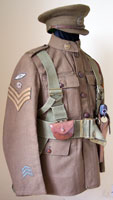
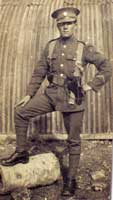 Introduced by List of Changes §16513, dated 5th March 1913 and 11th July 1913, the Patt. '08 Pistol Equipment was intended for soldiers who did not carry a rifle. Originally authorised for Pipers and Range-takers, use was later extended to machine gun crews, tank crews, OR's in the RFC, and others. Three new items were added to W.E. Pattern 1908 by §16513: the Attachments, brace; the Belt, waist, special; and the Loop, dirk. All of these are covered below, and are also addressed on the appropriate pages for Belts, Braces, and Straps.
Introduced by List of Changes §16513, dated 5th March 1913 and 11th July 1913, the Patt. '08 Pistol Equipment was intended for soldiers who did not carry a rifle. Originally authorised for Pipers and Range-takers, use was later extended to machine gun crews, tank crews, OR's in the RFC, and others. Three new items were added to W.E. Pattern 1908 by §16513: the Attachments, brace; the Belt, waist, special; and the Loop, dirk. All of these are covered below, and are also addressed on the appropriate pages for Belts, Braces, and Straps.
Two additional items were introduced in the L. of C. entry, to be used with the new Pistol Order. These are the Case, pistol, Webley, with brass hooks; and the Pouch, ammunition, Webley, with brass hooks. These are leather articles which did not receive the Pattern 1908 nomenclature, although they were specifically intended for use with it. Both the Pistol case and the Ammunition pouch are variations of earlier items, modified for use with the new web equipment. L. of C. §16513 also amended the nomenclature of these earlier versions.
The set of Pistol Equipment shown at left above is from the Peter Scott Collection. Photo © Peter Scott 2012. For more photos of Pistol Equipment sets, see the Pistol Equipment sections on the Pattern 1908 Pistol Equipment Set Displays page.
Web Equipment, Pattern 1908 - New Items
These are items added to W.E. Pattern 1908 by L. of C. §16513.

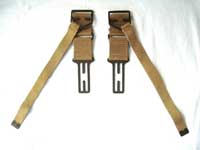
 Brace attachments replace the Cartridge carriers in the Patt. '08 Pistol Order. The digger at right has his Ammunition pouch pushed well back, giving a good view of the Brace attachments being worn. The ends of the 1-inch diagonal braces attach to the inner 1-inch buckles on the rear of the Belt, special. There were no changes to the Attachments, brace during their service life. This pair is maker marked "H.G.R. LD." and dated 1918. From the Barry O'Sullivan Collection. Photos © Barry O'Sullivan 2012.
Brace attachments replace the Cartridge carriers in the Patt. '08 Pistol Order. The digger at right has his Ammunition pouch pushed well back, giving a good view of the Brace attachments being worn. The ends of the 1-inch diagonal braces attach to the inner 1-inch buckles on the rear of the Belt, special. There were no changes to the Attachments, brace during their service life. This pair is maker marked "H.G.R. LD." and dated 1918. From the Barry O'Sullivan Collection. Photos © Barry O'Sullivan 2012.
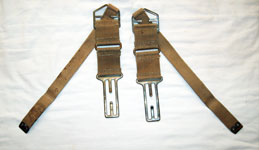
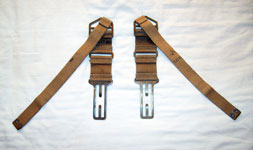
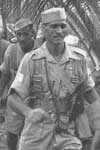 Another pair of Brace attachments, also maker marked "H.G.R. LD." and dated 1918. On this pair, note that the attachment buckle is upside down, with the "V" to the top. This follows an Indian practice, where the Brace attachment is worn back-to-front so that the buckle can be inverted. The diagonal brace is passed upwards and trapped under the 2-inch buckle on the Brace. This technique allows the Brace attachments to be worn on a standard Patt. '08 Belt. The photo at right, showing this method of wear, is taken from The Armed Forces of World War II. Uniforms, insignia and organisation by Andrew Mollo (Orbis Publishing, 1981). Also see the Pattern 1908 Pistol Equipment Set Displays page, where a modern set is shown in this configuration. From the Chris Pollendine Collection. Photos © Chris Pollendine 2012.
Another pair of Brace attachments, also maker marked "H.G.R. LD." and dated 1918. On this pair, note that the attachment buckle is upside down, with the "V" to the top. This follows an Indian practice, where the Brace attachment is worn back-to-front so that the buckle can be inverted. The diagonal brace is passed upwards and trapped under the 2-inch buckle on the Brace. This technique allows the Brace attachments to be worn on a standard Patt. '08 Belt. The photo at right, showing this method of wear, is taken from The Armed Forces of World War II. Uniforms, insignia and organisation by Andrew Mollo (Orbis Publishing, 1981). Also see the Pattern 1908 Pistol Equipment Set Displays page, where a modern set is shown in this configuration. From the Chris Pollendine Collection. Photos © Chris Pollendine 2012.

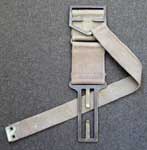

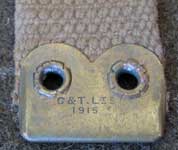 This pair of Brace attachments is maker marked "C & T Ltd." and dated 1915. We're not sure who C & T Ltd. were, but all of the Pattern 1908 equipment we've seen from that maker has been marked this way, stamped on the brass tips. From the Terry Hawker Collection. Photographs © Terry Hawker and Cathy Davis, 2013.
This pair of Brace attachments is maker marked "C & T Ltd." and dated 1915. We're not sure who C & T Ltd. were, but all of the Pattern 1908 equipment we've seen from that maker has been marked this way, stamped on the brass tips. From the Terry Hawker Collection. Photographs © Terry Hawker and Cathy Davis, 2013.
Belt, waist, special
Belt, waist, special, Mark I
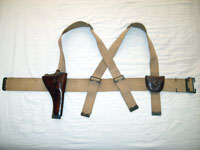
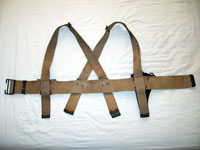 The Belt, waist, special is identical to the regular Belt except at the rear. The 2-inch buckled chapes do not have the down tabs found on the regular Belt, and there are two additional 1-inch buckled chapes on the inside, the buckles facing inward and down. These are used to secure the 1-inch angled straps at the rear of the Brace attachments. The nomenclature was changed to Belt, waist, special, Mark I by List of Changes entry L. of C. §17272, dated 26th May 1915. KW have not yet located an unmodified example of the Belt, waist, special, Mk. I. A pair of Braces were sewn to the Belt, in order to make a pistol set without the need for Brace attachments. Judging from period photographs, this sort of makeshift seems to have been common. The example shown here, very feintly maker marked "M.E. Co." and dated 1913, has been modified to have the inner 1-inch buckled chapes removed. The Belt is marked "RFC", which probably represents its original user. Both the Belt and the Braces have also been unit marked to the M.G.C.. From the Chris Pollendine Collection. Photos © Chris Pollendine 2012.
The Belt, waist, special is identical to the regular Belt except at the rear. The 2-inch buckled chapes do not have the down tabs found on the regular Belt, and there are two additional 1-inch buckled chapes on the inside, the buckles facing inward and down. These are used to secure the 1-inch angled straps at the rear of the Brace attachments. The nomenclature was changed to Belt, waist, special, Mark I by List of Changes entry L. of C. §17272, dated 26th May 1915. KW have not yet located an unmodified example of the Belt, waist, special, Mk. I. A pair of Braces were sewn to the Belt, in order to make a pistol set without the need for Brace attachments. Judging from period photographs, this sort of makeshift seems to have been common. The example shown here, very feintly maker marked "M.E. Co." and dated 1913, has been modified to have the inner 1-inch buckled chapes removed. The Belt is marked "RFC", which probably represents its original user. Both the Belt and the Braces have also been unit marked to the M.G.C.. From the Chris Pollendine Collection. Photos © Chris Pollendine 2012.
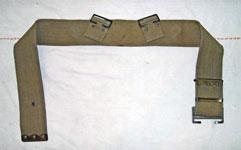
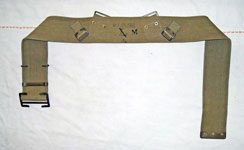 By 1913, when the Pistol Equipment was introduced, the Patt. '08 Belt, waist was available in three sizes. The Mark II version, which replaced the Mark I in List of Changes entry L. of C. §17272, dated 26th May 1915, made all three sizes of the Belt longer. "Small" size Belts were now to be 44 instead of 40-inches long; "Medium" Belts increased from 44 to 50 -inches, and "Large" Belts grew by 8-inches, from 48 to 56-inches. This example is a Belt, waist, special, Mk.II. Originally marked "L", this was struck through and it was remarked "M". Its actual length is about 54-inches. It is maker marked "M.E. Co." and dated 1919. From the Karkee Web Collection.
By 1913, when the Pistol Equipment was introduced, the Patt. '08 Belt, waist was available in three sizes. The Mark II version, which replaced the Mark I in List of Changes entry L. of C. §17272, dated 26th May 1915, made all three sizes of the Belt longer. "Small" size Belts were now to be 44 instead of 40-inches long; "Medium" Belts increased from 44 to 50 -inches, and "Large" Belts grew by 8-inches, from 48 to 56-inches. This example is a Belt, waist, special, Mk.II. Originally marked "L", this was struck through and it was remarked "M". Its actual length is about 54-inches. It is maker marked "M.E. Co." and dated 1919. From the Karkee Web Collection.

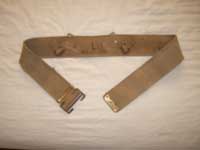
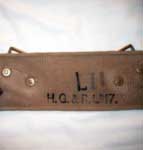 Another example of Belt, waist, special, Mk. II. This Belt is size marked "L". maker marked "H.G. & R.", and dated 1917. From the Chris Pollendine Collection. Photos © Chris Pollendine 2012.
Another example of Belt, waist, special, Mk. II. This Belt is size marked "L". maker marked "H.G. & R.", and dated 1917. From the Chris Pollendine Collection. Photos © Chris Pollendine 2012.
Belt, waist, special, "Economy"
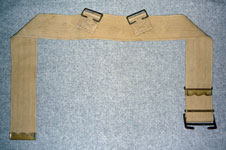
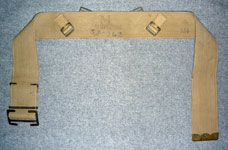 An interesting example of the Special waist belt that exhibits the "
economy" features adopted late in the war. As with the "Economy" Belt shown on the Belts page, the reinforcing rivets have been omitted from the rear tabs, and the flat rolled brass slide to the left of the buckle has been replaced with a brass wire loop. Also like the the other "Economy" Belt, it is maker marked "M.W. & S. Ltd." and dated 1918. Graham notes that the handwritten "S80343" is an Australian Militia regimental number from WW2. The overall length is 46-inches, which makes it nearer “S” rather than “M”. From the Graham Tweeddale Collection, photos © Graham Tweeddale 2012.
An interesting example of the Special waist belt that exhibits the "
economy" features adopted late in the war. As with the "Economy" Belt shown on the Belts page, the reinforcing rivets have been omitted from the rear tabs, and the flat rolled brass slide to the left of the buckle has been replaced with a brass wire loop. Also like the the other "Economy" Belt, it is maker marked "M.W. & S. Ltd." and dated 1918. Graham notes that the handwritten "S80343" is an Australian Militia regimental number from WW2. The overall length is 46-inches, which makes it nearer “S” rather than “M”. From the Graham Tweeddale Collection, photos © Graham Tweeddale 2012.
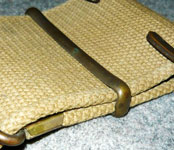 Detail of the brass wire slider. It is a flattened “D” section and contoured to the beaded edges of the Belt.
Detail of the brass wire slider. It is a flattened “D” section and contoured to the beaded edges of the Belt.

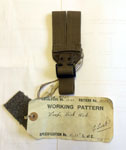

![]() L. of C. §16513 described the Loop, dirk as differing "from those referred to in §§ 2298 and 12423, in being made of 1-inch webbing instead of leather." This sealed pattern example is maker marked "MECo" and dated 1916. From the Richard Graham Collection, photos © Richard Graham 2019.
L. of C. §16513 described the Loop, dirk as differing "from those referred to in §§ 2298 and 12423, in being made of 1-inch webbing instead of leather." This sealed pattern example is maker marked "MECo" and dated 1916. From the Richard Graham Collection, photos © Richard Graham 2019.
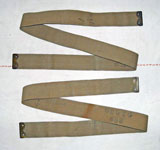
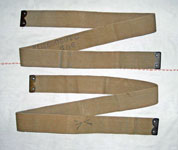 Braces were introduced as part of Web Equipment, Pattern 1908 in List of Changes entry L. of C. No. 14288, dated 31st January 1908. The second issue Braces were introduced by List of Changes entry L. of C. No. 15048, dated 22nd November 1909. Second issue Braces are straps of plain, heavy webbing, 50-inches long and 2-inches wide, tipped with sturdy eyeletted brass tips. When used in the W.E. Patt. '08 Pistol Order, the Braces are attached to the buckles on the rear of the Special waist belt, cross over the back, and connect to the Brace attachments at the front. Braces were the only previously introduced components of W.E. Patt. '08 that were
used in the new Pistol Order. As such, they are included here for completeness. This pair is maker marked "M.E. Co.", user marked "OUOTC" (Oxford University Officer Training Corps), and dated 1919. From the Karkee Web Collection.
Braces were introduced as part of Web Equipment, Pattern 1908 in List of Changes entry L. of C. No. 14288, dated 31st January 1908. The second issue Braces were introduced by List of Changes entry L. of C. No. 15048, dated 22nd November 1909. Second issue Braces are straps of plain, heavy webbing, 50-inches long and 2-inches wide, tipped with sturdy eyeletted brass tips. When used in the W.E. Patt. '08 Pistol Order, the Braces are attached to the buckles on the rear of the Special waist belt, cross over the back, and connect to the Brace attachments at the front. Braces were the only previously introduced components of W.E. Patt. '08 that were
used in the new Pistol Order. As such, they are included here for completeness. This pair is maker marked "M.E. Co.", user marked "OUOTC" (Oxford University Officer Training Corps), and dated 1919. From the Karkee Web Collection.
New Articles to be used with Web Equipment, Pattern 1908 Pistol Order
These leather articles, although introduced by L. of C. §16513, did not receive the W.E. Pattern 1908 nomenclature. They were, however, specifically intended for use with the Patt. '08 Pistol Order.Both of these, the Case, pistol, Webley and Pouch, ammunition, Webley, were new versions of items which were already in use. See the Pistol Case and Ammunition Pouch [FUTURE LINK TO BE ADDED] page of the Non-Patterned Equipment section for more information on other variations of these items.
Case, pistol, Webley, with brass hooks
Case, pistol, Webley, with brass hooks, Mark I
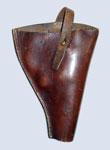
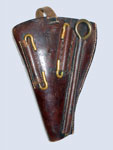 The Case, pistol, Webley, with brass hooks, as it was detailed in L. of C. §16513, is a sturdy leather envelope made for the Webley Mk. IV Pistol, with an open top and a single securing strap. Unlike its direct ancestor, the Case, pistol, Webley, with leather loops, the new version attaches to the Patt.'08 Belt with two double ended brass hooks. L. of C. §17176, which introduced the Mk. II version, amended the nomenclature of this Case to include the "Mark I" designation. In the rear view, note that the leather patch retaining the rearmost belt hook is a replacement. Given the amount of wear on the patch holding the front hook, this is hardly a surprise. This example of the Mk. I Case is maker marked "[illegible]T SADDLE CO. | BIRMINGHAM" and dated 1914. From the Karkee Web Collection.
The Case, pistol, Webley, with brass hooks, as it was detailed in L. of C. §16513, is a sturdy leather envelope made for the Webley Mk. IV Pistol, with an open top and a single securing strap. Unlike its direct ancestor, the Case, pistol, Webley, with leather loops, the new version attaches to the Patt.'08 Belt with two double ended brass hooks. L. of C. §17176, which introduced the Mk. II version, amended the nomenclature of this Case to include the "Mark I" designation. In the rear view, note that the leather patch retaining the rearmost belt hook is a replacement. Given the amount of wear on the patch holding the front hook, this is hardly a surprise. This example of the Mk. I Case is maker marked "[illegible]T SADDLE CO. | BIRMINGHAM" and dated 1914. From the Karkee Web Collection.
Case, pistol, Webley, with brass hooks, Mark II
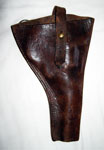
 The Case, pistol, Webley, with brass hooks, Mark II was introduced byL. of C. §17176, accepted 8th March, 1915. The Mk. II version was made 2-inches longer and slightly wider than the Mk. I, in order to accomodate the newly introduced Pistol, Webley, with 6-inch barrel (i.e., the Webley Mk. VI). The steel cleaning rod (note the length, compared to the Mk. IV rod shown above with the Mk.I Case), is also 1916 dated. This example of the Mk. II Case, from the Chris Pollendine Collection, is maker marked "H.G.R." and dated 1916.
The Case, pistol, Webley, with brass hooks, Mark II was introduced byL. of C. §17176, accepted 8th March, 1915. The Mk. II version was made 2-inches longer and slightly wider than the Mk. I, in order to accomodate the newly introduced Pistol, Webley, with 6-inch barrel (i.e., the Webley Mk. VI). The steel cleaning rod (note the length, compared to the Mk. IV rod shown above with the Mk.I Case), is also 1916 dated. This example of the Mk. II Case, from the Chris Pollendine Collection, is maker marked "H.G.R." and dated 1916.
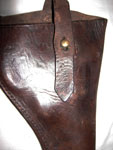
 Details of the Mk. II Pistol case shown above. Note that the muzzle of the Webley Mk. VI actually protrudes beyond the end of the Case. This is because over the years the Case has worn and belled at the top.
Details of the Mk. II Pistol case shown above. Note that the muzzle of the Webley Mk. VI actually protrudes beyond the end of the Case. This is because over the years the Case has worn and belled at the top.
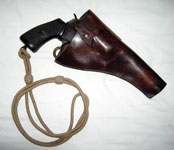
 A second example of the Case, pistol, Webley, with brass hooks, Mark II. This example is unmarked and undated. Note that the pistol fits perfectly in this less worn Case. Again, from the Chris Pollendine Collection. All Mk. II Pistol case photos shown left and above are © Chris Pollendine 2012.
A second example of the Case, pistol, Webley, with brass hooks, Mark II. This example is unmarked and undated. Note that the pistol fits perfectly in this less worn Case. Again, from the Chris Pollendine Collection. All Mk. II Pistol case photos shown left and above are © Chris Pollendine 2012.

 The leather lace on the rear of this Mk. II Pistol case is non-standard. It may have been added to make it useable with a B.E. Patt. ’03 Belt. The Belt would rest just on the top parts of the brass hooks. The Pistol case could be kept secure and in position by tying the lace round the Belt. Note also the rivets, top and bottom, which are bifurcated, where the Army used normally hose rivets. This is a later, user-mod, as it was not riveted at these points, as originally made. This Pistol case is maker marked "Wolfsky | London" and is dated 1917. From the Karkee Web Collection.
The leather lace on the rear of this Mk. II Pistol case is non-standard. It may have been added to make it useable with a B.E. Patt. ’03 Belt. The Belt would rest just on the top parts of the brass hooks. The Pistol case could be kept secure and in position by tying the lace round the Belt. Note also the rivets, top and bottom, which are bifurcated, where the Army used normally hose rivets. This is a later, user-mod, as it was not riveted at these points, as originally made. This Pistol case is maker marked "Wolfsky | London" and is dated 1917. From the Karkee Web Collection.

 A comparison of the Mk. I and Mk. II Cases, pistol, Webley, with brass hooks. As can be readily seen, the "shoe" of the Mk. II Case is about 2-inches longer than the Mk. I. The Mk. I Case is the same 1914 dated example shown above. The Mk. II Case is maker marked "H.G.R. Ltd." and dated 1917. This Case is also owner marked to "SUB-LIEUT. KLEBURN, T.E." on the rear. Lt. Thomas E. Kleburn, R.A.N., served as an Australian Naval Officer during WWII. Both from the Karkee Web Collection.
A comparison of the Mk. I and Mk. II Cases, pistol, Webley, with brass hooks. As can be readily seen, the "shoe" of the Mk. II Case is about 2-inches longer than the Mk. I. The Mk. I Case is the same 1914 dated example shown above. The Mk. II Case is maker marked "H.G.R. Ltd." and dated 1917. This Case is also owner marked to "SUB-LIEUT. KLEBURN, T.E." on the rear. Lt. Thomas E. Kleburn, R.A.N., served as an Australian Naval Officer during WWII. Both from the Karkee Web Collection.
Case, pistol, Webley, with brass hooks, Mark II (converted from Mk. I)


 In addition to introducing the new-made versions of the Case, pistol, Webley, with brass hooks, Mark II, and the Case, pistol, Webley, with leather loops, Mark II, L. of C. §17176 authorised modification of Mk. I Cases to Mark II specification, by the addition of a 2-inch leather extension onto the muzzle end of the Case. A detail of the way this extension was inserted can be seen in the photograph near left. The example shown here, modified from a Mk. I Case, is maker marked "Rendall, Underwood & Co. Ltd." and dated 1914. From the Terry Hawker Collection. Photos © 2018 Terry Hawker.
In addition to introducing the new-made versions of the Case, pistol, Webley, with brass hooks, Mark II, and the Case, pistol, Webley, with leather loops, Mark II, L. of C. §17176 authorised modification of Mk. I Cases to Mark II specification, by the addition of a 2-inch leather extension onto the muzzle end of the Case. A detail of the way this extension was inserted can be seen in the photograph near left. The example shown here, modified from a Mk. I Case, is maker marked "Rendall, Underwood & Co. Ltd." and dated 1914. From the Terry Hawker Collection. Photos © 2018 Terry Hawker.

 The photo near left, taken in 1928 and furnished by Chris Pollendine, shows a converted Case, pistol, Webley, with brass hooks, Mark II. The unit is I Battalion, later 9th Battalion, Royal Tank Corps. The photo far left shows a converted Case, pistol, Webley, with leather loops, Mark II. This photo was copied from Stephen Chamber's weighty tome Uniforms & Equipment of the British Army in World War I: A Study in Period Photographs, and is used here with the kind permission of the author.
The photo near left, taken in 1928 and furnished by Chris Pollendine, shows a converted Case, pistol, Webley, with brass hooks, Mark II. The unit is I Battalion, later 9th Battalion, Royal Tank Corps. The photo far left shows a converted Case, pistol, Webley, with leather loops, Mark II. This photo was copied from Stephen Chamber's weighty tome Uniforms & Equipment of the British Army in World War I: A Study in Period Photographs, and is used here with the kind permission of the author.
Case, pistol, with brass hooks, Mark II



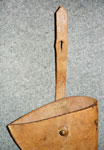 The final modification of the Case, pistol, Webley, with brass hooks, Mark II was introduced by L. of C. §A2394, approved 18th February, 1927. The nomenclature was amended to Case, pistol, with brass hooks, Mark II (without the "Webley"). Additionally, the pattern was modified to close the muzzle end of the Case by a leather insert with three vent holes. As with the 1915 modification, this change applied to both new made Cases and to existing ones on charge, which were to be modified to meet the new specification. The example shown here is maker marked "WB & Co." and dated 1917. As can be seen, the muzzle end has been closed with an insert in accordance with §A2394. From the Graham Tweeddale Collection, photos © Graham Tweeddale 2012.
The final modification of the Case, pistol, Webley, with brass hooks, Mark II was introduced by L. of C. §A2394, approved 18th February, 1927. The nomenclature was amended to Case, pistol, with brass hooks, Mark II (without the "Webley"). Additionally, the pattern was modified to close the muzzle end of the Case by a leather insert with three vent holes. As with the 1915 modification, this change applied to both new made Cases and to existing ones on charge, which were to be modified to meet the new specification. The example shown here is maker marked "WB & Co." and dated 1917. As can be seen, the muzzle end has been closed with an insert in accordance with §A2394. From the Graham Tweeddale Collection, photos © Graham Tweeddale 2012.
Case, pistol, with brass hooks (I. P.) (?)

 In the 1930's photo near left, also used above to illustrate an alternative, Indian manner of employing Brace attachments, this Pistol case is present. In the painting far left, also from Andrew Mollo's The Armed Forces of World War II, a portion of the back of the holster can be seen, with the presence of the cleaning rod confirming that this is the same type of holster. Judging by the rank of the men in both the photo and the painting, it would appear that these Pistol cases were issued to Non-Commissioned Officers, both being Havildars.
In the 1930's photo near left, also used above to illustrate an alternative, Indian manner of employing Brace attachments, this Pistol case is present. In the painting far left, also from Andrew Mollo's The Armed Forces of World War II, a portion of the back of the holster can be seen, with the presence of the cleaning rod confirming that this is the same type of holster. Judging by the rank of the men in both the photo and the painting, it would appear that these Pistol cases were issued to Non-Commissioned Officers, both being Havildars.
![]() This Northamptonshire Regiment soldier, rank unknown, is shown on the N.W. Frontier in the 1930s, wearing an I.P. Case on his Patt. ’08 W.E. pistol set. Slender though this evidence is, it suggests that British Army units may have acquired the I.P. Case. There are precedents for British troops using India Pattern items - British troops in the Boer War, arriving direct from India, had enamelled I.P. Water bottles, as did a Scottish unit in Mesopotamia, during the Great War. This photo is a crop from a photo here:
This Northamptonshire Regiment soldier, rank unknown, is shown on the N.W. Frontier in the 1930s, wearing an I.P. Case on his Patt. ’08 W.E. pistol set. Slender though this evidence is, it suggests that British Army units may have acquired the I.P. Case. There are precedents for British troops using India Pattern items - British troops in the Boer War, arriving direct from India, had enamelled I.P. Water bottles, as did a Scottish unit in Mesopotamia, during the Great War. This photo is a crop from a photo here:
https://www.flickr.com/photos/northampton_museum/5044010156/in/set-72157625077918924.

 The above nomenclature is an ascribed one, based on the standard Army nomenclature for the open-top version, as it is quite obviously a member of the Pattern 1908 family of holsters. In the mid-1970's, a pile of these holsters were found by the previous owner at a surplus store in a town outside Delhi - hence the India Pattern suffix in the proposed terminology. No entry can be found in the U.K. Priced Vocabularies, but illustrations show it being worn by Indian troops, in India and North Africa. One example noted is stamped Ca 1940 for Cawnpore. This example is marked Ca 1918, but is additionally marked BUFFS, a.k.a. The Royal East Kent Regiment. It has been modified by the addition of a riveted belt loop. Viewed from the front, it appears to be a typical, officer's Sam Browne Pistol case for a six-inch barrel revolver. It does indeed have those same dimensions. However, the three-inch brass hooks and cleaning rod sleeve on the back testify to the fact that this actually more closely related to a Mark II Case, but with the added refinement of a cover, the military term for a flap - a very sensible feature in a country subject to monsoons. From the John Bodsworth Collection Photographs © J. Bodsworth 2016.
The above nomenclature is an ascribed one, based on the standard Army nomenclature for the open-top version, as it is quite obviously a member of the Pattern 1908 family of holsters. In the mid-1970's, a pile of these holsters were found by the previous owner at a surplus store in a town outside Delhi - hence the India Pattern suffix in the proposed terminology. No entry can be found in the U.K. Priced Vocabularies, but illustrations show it being worn by Indian troops, in India and North Africa. One example noted is stamped Ca 1940 for Cawnpore. This example is marked Ca 1918, but is additionally marked BUFFS, a.k.a. The Royal East Kent Regiment. It has been modified by the addition of a riveted belt loop. Viewed from the front, it appears to be a typical, officer's Sam Browne Pistol case for a six-inch barrel revolver. It does indeed have those same dimensions. However, the three-inch brass hooks and cleaning rod sleeve on the back testify to the fact that this actually more closely related to a Mark II Case, but with the added refinement of a cover, the military term for a flap - a very sensible feature in a country subject to monsoons. From the John Bodsworth Collection Photographs © J. Bodsworth 2016.



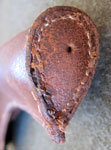 This example is made from leather that is about half the thickness of a standard Mark II Case - consequently it weighs considerably less than that open-topped holster. Like the rest of the Patt.'08 leather holster family, this case was manufactured using the flat-stitched method of construction, as opposed to the finer quality butt-stitch process employed with officers’ Sam Browne cases. From the Terry Hawker Collection. Original photographs © Terry Hawker and Cathy Davis, 2016.
This example is made from leather that is about half the thickness of a standard Mark II Case - consequently it weighs considerably less than that open-topped holster. Like the rest of the Patt.'08 leather holster family, this case was manufactured using the flat-stitched method of construction, as opposed to the finer quality butt-stitch process employed with officers’ Sam Browne cases. From the Terry Hawker Collection. Original photographs © Terry Hawker and Cathy Davis, 2016.
Pouch, ammunition, Webley, with brass hooks
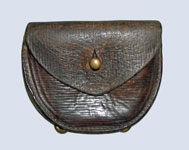
 The Pouch, ammunition, Webley, with brass hooks is used in the Patt. '08 Pistol Order. It is a simple leather pouch, the body formed by just two pieces of leather and designed to hold 12 rounds of ammunition for the Webley Mk. IV Pistol. It attaches to the Belt with two double ended brass hooks. This example is maker marked "H.G.R." and is dated 1917. As with the Pistol case, this Pouch is a modification of the Pouch, ammunition, brown, pistol , the previous nomenclature for what was a Victorian design. From the Karkee Web Collection.
The Pouch, ammunition, Webley, with brass hooks is used in the Patt. '08 Pistol Order. It is a simple leather pouch, the body formed by just two pieces of leather and designed to hold 12 rounds of ammunition for the Webley Mk. IV Pistol. It attaches to the Belt with two double ended brass hooks. This example is maker marked "H.G.R." and is dated 1917. As with the Pistol case, this Pouch is a modification of the Pouch, ammunition, brown, pistol , the previous nomenclature for what was a Victorian design. From the Karkee Web Collection.

 The photo at left, taken from the manual of Elementary Drill (All Arms), 1935, shows the approved method of wearing the Patt. '08 Pistol Order. The Ammunition pouch is on the right side, in front of the Brace attachment. The Pistol case is worn in front of the Brace attachment on the left, set up for a cross draw. Looking at the Pistol case in particular, this seems the natural and obvious way to wear this equipment. A fair number of period photographs, though, indicate that this view was by no means universally held during the Great War. The photo at right shows a group of RFC Other Ranks in 1915, wearing Pistol Order over their maternity tunics. Every man in the picture has the Pistol case on the right. If the Special waist belt was worn low on the hips, Old West style, this might be reasonable. With the Belt high on the waist, though, as these men have it, it must have been very awkward to draw the Pistol from the Case. This can't be dismissed as an anomaly, since quite a number of period photographs show Pistol Order being worn in this fashion. Of course, France in 1915 wasn't the Wild West, and the ability to perform a gunslinger's quick draw was not the purpose of this equipment. Still, it does seem odd.
The photo at left, taken from the manual of Elementary Drill (All Arms), 1935, shows the approved method of wearing the Patt. '08 Pistol Order. The Ammunition pouch is on the right side, in front of the Brace attachment. The Pistol case is worn in front of the Brace attachment on the left, set up for a cross draw. Looking at the Pistol case in particular, this seems the natural and obvious way to wear this equipment. A fair number of period photographs, though, indicate that this view was by no means universally held during the Great War. The photo at right shows a group of RFC Other Ranks in 1915, wearing Pistol Order over their maternity tunics. Every man in the picture has the Pistol case on the right. If the Special waist belt was worn low on the hips, Old West style, this might be reasonable. With the Belt high on the waist, though, as these men have it, it must have been very awkward to draw the Pistol from the Case. This can't be dismissed as an anomaly, since quite a number of period photographs show Pistol Order being worn in this fashion. Of course, France in 1915 wasn't the Wild West, and the ability to perform a gunslinger's quick draw was not the purpose of this equipment. Still, it does seem odd.